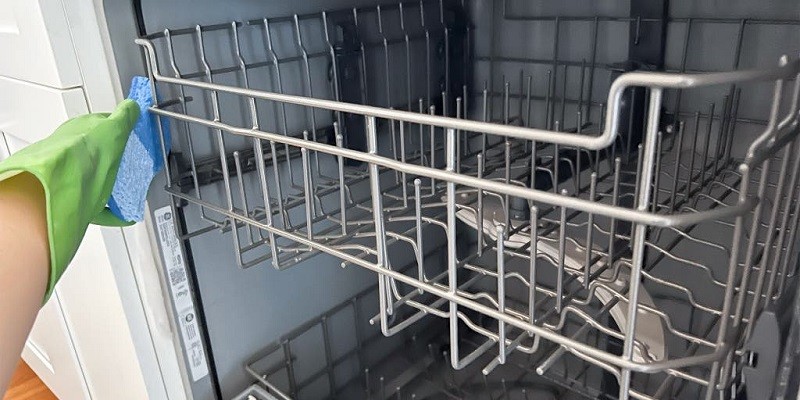To clean a moldy dishwasher, remove the racks and filter, scrub the interior with a mixture of bleach and water, and rinse thoroughly. A moldy dishwasher can be a breeding ground for harmful bacteria and create unpleasant odors in your kitchen.
Proper cleaning and maintenance are essential to keep your dishwasher running efficiently and ensure clean, sanitized dishes. In this article, we will provide you with step-by-step instructions on how to clean a moldy dishwasher, as well as tips for preventing mold growth in the future.
Follow these guidelines to keep your dishwasher fresh, clean, and ready for use.

Credit: www.reddit.com
Signs And Causes Of A Moldy Dishwasher
Cleaning a moldy dishwasher may not be on the top of your to-do list, but neglecting this task can lead to unpleasant odors and even health issues. Signs of a moldy dishwasher are not always obvious, so it’s important to understand what to look out for.
Additionally, knowing the common causes of mold growth in dishwashers can help you prevent this problem from occurring in the first place. In this section, we’ll explore the signs and causes of a moldy dishwasher, so you can take the necessary steps to keep your dishwasher clean and fresh.
The Signs Of A Moldy Dishwasher
- Lingering unpleasant odors: If your dishwasher emits a musty or moldy smell, it could be a sign of mold growth.
- Visible mold or mildew: Check the nooks and crannies of your dishwasher, such as the door gasket, silverware compartments, and other hidden areas, for any signs of mold or mildew.
- Discolored or stained interior: Mold growth can lead to discoloration or staining on the interior walls of your dishwasher.
- Residue or slime buildup: Mold and mildew can leave behind residue or slimy deposits on dishes, utensils, or the dishwasher itself.
- Allergy symptoms: If you or your family members experience frequent sneezing, coughing, or watery eyes after using the dishwasher, it could indicate mold-related allergies.
Common Causes Of Mold Growth In Dishwashers
- Moisture buildup: Excess moisture, combined with warmth and darkness, creates an ideal environment for mold to thrive. This can result from faulty seals, leaky pipes, or improper ventilation.
- Food debris: Food particles left behind in the dishwasher provide a food source for mold and encourage its growth.
- Dirty filters or clogged drain: A clogged drain or dirty filters prevent proper drainage, causing water to accumulate and create a breeding ground for mold.
- Improper cleaning routine: Neglecting regular cleaning and maintenance of your dishwasher can contribute to mold growth over time.
- Using the wrong detergent: Certain dishwasher detergents may not effectively remove bacteria and mold, allowing them to multiply.
By being aware of the signs of a moldy dishwasher and understanding the common causes, you can take proactive steps to prevent mold growth and maintain a clean and odor-free dishwasher. In the next section, we’ll explore effective methods for cleaning a moldy dishwasher and keeping it mold-free in the future.
Preparing The Dishwasher For Cleaning
Before you start the process of cleaning a moldy dishwasher, it’s important to gather the necessary cleaning supplies and ensure safety measures are in place. By following these steps, you can ensure a thorough and effective cleaning process.
Gathering Necessary Cleaning Supplies:
- Dishwashing detergent: Choose a detergent specifically designed for dishwashers to ensure effective removal of mold and bacteria.
- White vinegar: Vinegar is a natural cleaner that can help remove mold and deodorize your dishwasher.
- Baking soda: Baking soda can be used as a gentle abrasive to scrub away stubborn mold stains.
- Toothbrush or soft-bristled brush: These brushes can be used to clean hard-to-reach areas and remove mold buildup.
- Microfiber cloth: Opt for a microfiber cloth to wipe down the interior of the dishwasher and remove any remaining grime.
- Rubber gloves: Protect your hands from harsh cleaning chemicals by wearing rubber gloves throughout the cleaning process.
Ensuring Safety Measures Are In Place:
- Turn off the dishwasher: Before you begin cleaning, make sure the dishwasher is unplugged or turned off at the circuit breaker to avoid any accidents.
- Remove any dishes or utensils: Clear out the dishwasher and remove any dishes or utensils before you start the cleaning process.
- Empty the filter: Most dishwashers have a removable filter that collects food particles. Take out the filter and rinse it thoroughly to remove any debris.
- Ventilate the area: Open nearby windows or turn on the exhaust fan to ensure proper ventilation during the cleaning process.
- Read the manufacturer’s instructions: Familiarize yourself with the specific guidelines provided by the dishwasher manufacturer to ensure that you clean it correctly without voiding any warranties.
With these preparations in place, you are now ready to tackle the task of cleaning your moldy dishwasher. Following the rest of the steps will help bring your dishwasher back to its optimal performance and keep it mold-free in the future.
Cleaning The Interior Of The Dishwasher
When it comes to cleaning a moldy dishwasher, one of the essential steps is to focus on the interior. Cleaning the interior thoroughly helps eliminate mold, debris, and any lingering food particles, ensuring that your dishwasher is hygienic and efficient.
Here’s how you can clean the interior of your dishwasher effectively:
Removing Debris And Food Particles
- Start by removing any large debris like food scraps or utensils that may be stuck in the dishwasher.
- Use a soft brush or toothbrush to gently scrub the interior walls, removing any smaller debris that may be present.
- Pay particular attention to the corners and crevices where mold and grime tend to accumulate.
- Wipe down the interior surfaces with a damp cloth to ensure all debris is removed.
Treating Mold With Vinegar Or Hydrogen Peroxide Solution
- To tackle mold and mildew, create a cleaning solution by mixing equal parts water and vinegar or hydrogen peroxide.
- Using a spray bottle, apply the solution to the interior of the dishwasher, focusing on mold-prone areas.
- Let the solution sit for about 15 minutes to allow it to penetrate and loosen the mold.
- Afterward, scrub the affected areas with a brush or sponge, ensuring thorough coverage.
- Rinse the interior surfaces with water to remove any residue.
Cleaning The Filter And Spray Arms
- Locate the dishwasher’s filter and remove it according to the manufacturer’s instructions.
- Rinse the filter under warm water to remove any accumulated debris or food particles.
- Use a brush or toothpick to dislodge stubborn grime from the filter.
- Clean the spray arms by removing them from the dishwasher and soaking them in warm soapy water.
- Use a small brush to clean any clogged spray holes.
- Rinse the filter and spray arms thoroughly and reattach them to the dishwasher.
By following these simple steps, you can effectively clean the interior of your moldy dishwasher, ensuring optimal performance and hygiene. Regular maintenance and cleaning will not only extend the lifespan of your dishwasher but also maintain the quality of your dishes and glassware.
Frequently Asked Questions On How To Clean A Moldy Dishwasher?
How Can I Tell If My Dishwasher Has Mold?
If you notice a strong, musty odor or black spots on the interior walls, racks, or seals, your dishwasher may have mold.
What Causes Mold In A Dishwasher?
Mold in a dishwasher is often caused by leftover food particles, grease, and moisture that create a favorable environment for mold growth.
Can I Use Bleach To Clean A Moldy Dishwasher?
Yes, you can use a solution of bleach and water to kill mold in your dishwasher, but make sure to follow the manufacturer’s guidelines.
Are There Any Natural Alternatives To Bleach For Cleaning A Moldy Dishwasher?
Yes, vinegar and baking soda can be effective natural alternatives to bleach for cleaning and removing mold from your dishwasher.
How Often Should I Clean My Dishwasher To Prevent Mold Growth?
It is recommended to clean your dishwasher at least once a month to prevent mold growth and ensure its optimal performance.
Conclusion
To ensure a mold-free dishwasher, regular cleaning and maintenance are key. By following the steps outlined in this blog post, you can effectively eliminate mold and keep your dishwasher running smoothly. Remember to start by removing any visible debris from the dishwasher and scrubbing the interior with a mixture of vinegar and water.
Pay special attention to the corners, seals, and filters, as these are common areas where mold can grow. Afterward, run a cycle with baking soda or bleach to further sanitize the dishwasher. To prevent future mold growth, make sure to keep the dishwasher dry by wiping down the interior after each use and leaving the door slightly open to allow for air circulation.
By incorporating these cleaning habits into your routine, you can enjoy a mold-free dishwasher and have confidence in serving clean dishes to your family.
Editorial Recommendations:
- How To Clean Dishwasher Drain Hose Without Removing It?
- How To Clean Guitar Fretboard?
- How To Clean An Acoustic Guitar?
Last Updated on August 7, 2025 by Marjorie R. Rogers, MA (English), Certified Consultant




